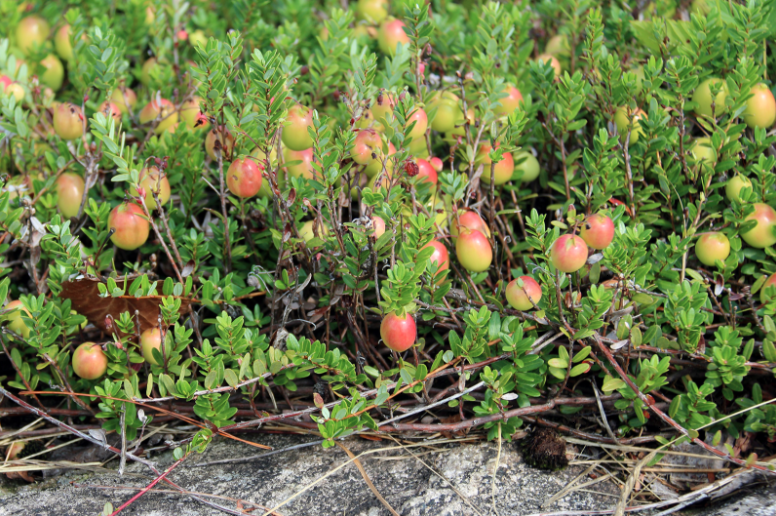Cranberries grow on low-lying vines in bogs uniquely designed to create an ideal growing environment for the fruit.
As you can see in the image below, the vines grow on dry land!
If the cranberry vine remains healthy and undamaged they can survive for centuries. There are vines in Cape Cod that are more than 150 years old. Fun fact, the cranberry is believed to be native to the United States.

The wetland
The vines grow on a few layers of earth.
The bottom earth bed is typically clay-like with layers of gravel, peat, and sand. The original bogs or marshes were created by glacial deposits. Today commercial farmers replicate the original growing environment and use a system of ponds, wetlands, flooding, and ditches to support the continual growth and harvest of the cranberry crop.

The cranberry bogs begin and end each season with a flood. Each season plays an important role and fall steals the show with the beauty of the wet harvest.
Season: Winter
At the end of each season, the bogs are flooded to protect against the harsh winter weather. The flooded bog freezes and a layer of sand are spread across the ice to further protect the vines and crops below.
Season: Spring
The ice thaws during the spring and the crop beings wake up after its long winter slumber. During the spring the bog may be flooded again to protect against insects, manage the growth of weeds, and prevent disease.
Season: Summer
The cranberry blossoms appear in the summer, commonly late June into July. Beautiful shades of pink paint the cranberry fields as these unique flowers bloom.
Did you ever wonder why it’s named a cranberry? The flower blossoms resemble a crane’s head. Cranberry derives from crane-berry.

Pollination
Our friend the honey bee is a critical part of the growing process as cranberry flowers can’t self-fertilize. The fruit needs the help of the animal kingdom to fertilize the bog.
Honey bees are used by farmers during the summer months to pollinate the flowers. The farmers need to carefully deliver the bees to the cranberry fields. The cranberry blossoms don’t offer as sweet a nectar as other flowers so bees will often fly off to find other flowers. It seems even the bees know that fresh cranberry juice is very tart!
The next season is fall. Enter the beauty of the wet harvest! The flooded bogs are why so many people think cranberries grow in water.

Fall is Harvest Season
During the fall cranberries reach their peak color and flavor. In the U.S. the harvest season is typically mid-September into November. There are two methods used for harvesting cranberries, wet and dry harvesting.
Wet harvesting
Over 90% of the cranberry crop is wet harvested each year. Wet harvested cranberries are used for juices, sauces, sweetened dried cranberries, and as ingredients in other processed foods.
Steps of the wet harvest
- Flood the bog! The cranberry vines are flooded with up to 18 inches of water.
- Shake it up! The day after the bog is flooded farmers use reels to churn the water and loosen the cranberries from their vine.
- To the surface! Inside every cranberry are four tiny air pockets. Unlike the titanic these air pockets help the cranberry float to the water’s surface.
- Round up the berries! Now that the cranberries are floating and loose from the vines, they are loaded into trucks and shipped off to be processed and turned into wonderful cranberry products. Obviously we like the pure cranberry juice best of all.

Dry harvesting
The other 10% of cranberries grown each year are dry harvested. These are the fresh cranberries bought in your local store or farmer’s market. With this method farmers use a mechanical picker that combs the berries off the vine. The machine looks like a large and oddly shaped lawn mower.
Where do all these cranberries grow?
Major production states of U.S. cranberries are:
- Wisconsin
- New Jersey
- Massachusetts
- Oregon
- Washington
Check out our Data & Trends section to see how many millions of cranberries grow in the U.S. each year.
